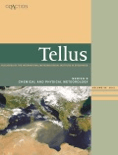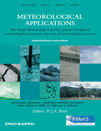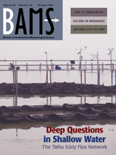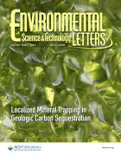
Atmospheric Environment-X
Scope & Guideline
Bridging research and real-world solutions for our environment.
Introduction
Aims and Scopes
- Air Quality Assessment and Management:
The journal publishes research on methods and technologies for assessing air quality, including the evaluation of pollutants and their sources, as well as strategies for air quality management in urban and rural settings. - Source Apportionment and Emission Inventories:
A significant focus is on identifying sources of atmospheric pollutants through advanced modeling and monitoring techniques, including receptor models and land-use regression analysis. - Impact of Meteorology on Air Quality:
Research frequently explores the influence of meteorological conditions on air quality, including studies on temperature, humidity, and wind patterns and their effects on pollutant dispersion and concentration. - Health and Environmental Impacts of Air Pollution:
The journal addresses the health effects associated with air pollution exposure, linking atmospheric studies to public health outcomes and environmental policies. - Innovative Analytical Techniques and Technologies:
Atmospheric Environment-X highlights the development and application of new technologies and analytical methods for measuring and modeling atmospheric phenomena.
Trending and Emerging
- Urban Air Quality and Traffic Emissions:
There is an increasing focus on the impact of urbanization and traffic patterns on air quality, particularly in rapidly developing regions, highlighting the need for targeted emission reduction strategies. - Climate Change and Atmospheric Interactions:
Research on the interconnections between climate change and atmospheric processes is trending, particularly studies examining how changing climate conditions affect air quality and pollutant behavior. - Advanced Emission Reduction Technologies:
Emerging themes include the development and evaluation of technologies aimed at reducing emissions from various sources, such as transportation and industrial processes, reflecting a proactive approach to air quality management. - Health Risk Assessments Related to Air Pollution:
An increasing number of studies are linking air quality data to health outcomes, emphasizing the need for integrated assessments that consider both environmental and public health perspectives. - Use of Remote Sensing and Big Data Analytics:
The application of remote sensing technologies and big data analytics in atmospheric research is on the rise, facilitating more comprehensive and real-time assessments of air quality across large geographic areas.
Declining or Waning
- Traditional Air Quality Monitoring Techniques:
Papers relying solely on conventional air quality monitoring methods are becoming less common, as there is a growing trend towards using advanced modeling and remote sensing technologies. - Generalized Studies on Global Atmospheric Trends:
Research that lacks localized context or specific case studies is declining, as more emphasis is placed on detailed, region-specific investigations that provide actionable insights for local policy. - Focus on Individual Pollutants:
There is a noticeable shift away from studies examining individual pollutants in isolation, with a greater emphasis on understanding interactions between multiple pollutants and their cumulative effects.
Similar Journals

Atmosphere-Korea
Fostering Understanding of Climate Impacts on SocietyAtmosphere-Korea is a prestigious journal published by the Korean Meteorological Society, dedicated to advancing the field of atmospheric sciences. With a focus on both theoretical and applied research, this journal encompasses a wide range of topics including meteorology, climatology, and environmental science, providing a platform for researchers to disseminate their findings and enhance scientific dialogue. Although currently not categorized under an open access model, the journal ensures that all articles meet rigorous scientific standards, thereby maintaining its credibility and academic integrity. The ISSN 1598-3560 and E-ISSN 2288-3266 identify its unique contributions to global knowledge in meteorology. Researchers, professionals, and students alike benefit from the invaluable insights offered through its publications, making Atmosphere-Korea an essential resource in understanding climatic phenomena and their implications for society.

Environmental Science-Atmospheres
Connecting minds through open-access environmental research.Environmental Science-Atmospheres is an emerging and dynamic open-access journal published by the Royal Society of Chemistry, dedicated to advancing research in the fields of environmental science and atmosphere-related studies. Launched in 2021, this journal serves as an essential platform for disseminating cutting-edge findings that address the complexities of atmospheric phenomena, pollution impacts, and overall environmental health. With a commendable Q2 ranking across various categories including Environmental Chemistry and Pollution, it solidifies its position as a vital resource for researchers, professionals, and students seeking to contribute to the understanding of environmental dynamics. The journal is indexed in Scopus, providing its contributors with significant visibility within the scientific community. Operating under a fully Open Access model since its inception, Environmental Science-Atmospheres ensures that research outputs are freely accessible, fostering collaboration and knowledge sharing essential for tackling global environmental challenges.

TELLUS SERIES B-CHEMICAL AND PHYSICAL METEOROLOGY
Fostering collaboration for a deeper meteorological insight.TELLUS SERIES B-CHEMICAL AND PHYSICAL METEOROLOGY, published by Stockholm University Press, is a leading open-access journal dedicated to the advanced study of atmospheric sciences, specializing in the chemical and physical aspects of meteorology. With an ISSN of 1600-0889, this journal has been committed to disseminating high-quality research since its transition to open access in 2012, ensuring that cutting-edge discoveries are freely available to the global research community. The journal's scope encompasses a wide range of topics within meteorology, attracting contributions from both established and emerging researchers in the field. The importance of this journal lies in its ability to bridge gaps in knowledge and foster collaboration among scientists, making it an essential resource for professionals and students alike who seek to deepen their understanding of atmospheric phenomena. For submissions and further information, please refer to the Stockholm University Press website.

ADVANCES IN ATMOSPHERIC SCIENCES
Fostering Innovation in Meteorological StudiesADVANCES IN ATMOSPHERIC SCIENCES is a highly esteemed journal published by SCIENCE PRESS, dedicated to advancing the field of atmospheric sciences. With an impressive impact factor and ranking as Q1 in Atmospheric Science as of 2023, this journal serves as a leading platform for researchers, professionals, and students to disseminate substantial findings and innovative methodologies across various topics within the atmospheric sciences domain. Established in 1984 and continuously publishing through to 2024, it has successfully positioned itself among the top ranks, currently standing at #17 out of 148 in the Scopus category, highlighting its significance in the field with a remarkable 88th percentile. Although it operates under traditional access, the journal provides invaluable insights into climate dynamics, meteorology, and environmental processes that are crucial for both academic and practical applications. Based in Beijing, China, ADVANCES IN ATMOSPHERIC SCIENCES is committed to fostering a global dialogue and collaboration among scholars and industry experts, making it an essential resource for those invested in understanding and addressing contemporary atmospheric challenges.

METEOROLOGICAL APPLICATIONS
Advancing the Frontiers of Atmospheric ScienceMETEOROLOGICAL APPLICATIONS is an esteemed journal published by WILEY that has been a vital resource in the field of atmospheric science since its inception in 1994. With an Impact Factor indicative of its credibility and influence in the academic community, the journal has notably achieved a Q2 ranking in the 2023 category quartiles for Atmospheric Science, demonstrating its commitment to advancing knowledge in meteorology. As an Open Access journal since 2020, it provides widespread accessibility to researchers, professionals, and students, promoting collaborative efforts in the pursuit of innovative solutions to atmospheric challenges. With its dedicated focus on interdisciplinary studies in meteorology, METEOROLOGICAL APPLICATIONS serves as a crucial platform for sharing cutting-edge research and fostering dialogue among experts, thereby enhancing our understanding of weather phenomena and their global impacts. For submissions and accessing articles, the journal can be found at WILEY’s headquarters in Hoboken, NJ, representing a hub for scholarly discourse in the atmospheric sciences.

BULLETIN OF THE AMERICAN METEOROLOGICAL SOCIETY
Connecting researchers and practitioners in the pursuit of meteorological excellence.BULLETIN OF THE AMERICAN METEOROLOGICAL SOCIETY, published by the American Meteorological Society, stands as a premier forum in the field of meteorology and atmospheric science, boasting an impressive ranking in the Q1 category for 2023. With a long-standing history dating back to 1972, this journal serves as a vital resource for researchers, practitioners, and students dedicated to advancing the understanding of atmospheric phenomena. The journal facilitates the dissemination of cutting-edge research, innovative methodologies, and significant findings that propel the scientific community forward. Although not an Open Access journal, it remains a critical publication for comprehending complex environmental interactions, climate change, and weather-related phenomena. The BULLETIN OF THE AMERICAN METEOROLOGICAL SOCIETY is essential reading for anyone invested in atmospheric sciences, providing invaluable insights that shape policy, enhance safety, and promote environmental sustainability.

Asian Journal of Atmospheric Environment
Exploring Innovative Solutions for Environmental ChallengesAsian Journal of Atmospheric Environment, published by SPRINGERNATURE, is a renowned open-access journal established in 2007, dedicated to advancing research in the fields of Atmospheric Science and Environmental Science. With an ISSN of 1976-6912 and E-ISSN of 2287-1160, the journal aims to offer a platform for the dissemination of cutting-edge research findings, reviews, and innovative methodologies addressing critical environmental issues faced in Asian and global contexts. As of 2023, it holds a respectable Q3 ranking in both Atmospheric Science and Environmental Science categories, positioning itself within the competitive landscape of scholarly publications. The journal is indexed in Scopus and emphasizes its commitment to enhancing accessibility and widespread dissemination of knowledge, making significant contributions to environmental sustainability and atmospheric research. Researchers, professionals, and students are encouraged to engage with the journal as it continues to evolve through its converged years, providing a vital resource for exploring and addressing the challenges that shape our atmospheric environment.

Atmospheric Science Letters
Unlocking the secrets of the Earth's atmosphere.Atmospheric Science Letters, published by WILEY, is a leading open-access journal in the field of Atmospheric Science. Since its establishment in 2000, it has significantly contributed to advancing knowledge related to the Earth's atmosphere, focusing on both theoretical and practical aspects. With an impressive Q2 ranking in the Atmosphere Science category as of 2023 and a Scopus rank of 62 out of 148, this journal provides a platform for researchers and professionals to share their findings and insights. The journal’s commitment to open access since 2016 ensures that cutting-edge research is accessible to a global audience, fostering collaboration and innovation in the atmospheric sciences. Addressed from its headquarters at 111 River St, Hoboken, NJ, USA, Atmospheric Science Letters is pivotal for students, researchers, and professionals seeking to stay abreast of the latest developments in this dynamic field.

Environmental Science & Technology Letters
Unlocking innovative solutions to ecological challenges.Environmental Science & Technology Letters, published by the American Chemical Society, stands as a premier journal in the realm of environmental science and technology, focusing on pivotal studies that address pressing environmental challenges. With an impressive Q1 ranking in multiple categories including Ecology, Environmental Chemistry, and Pollution, this journal maintains a position of excellence within its field, achieving Scopus ranks that place it in the top percentile of Environmental Science disciplines. Although not open access, Environmental Science & Technology Letters offers vital insights and cutting-edge research that contribute significantly to the understanding and management of environmental issues. The journal’s objectives include disseminating ground-breaking findings and promoting discussions that lead to sustainable solutions. With convergence from 2013 to 2024, it continues to serve as an essential resource for researchers, professionals, and students committed to advancing knowledge and innovation in environmental science.

ATMOSFERA
Exploring the Dynamics of Our AtmosphereATMOSFERA is a prestigious journal published by CENTRO CIENCIAS ATMOSFERA UNAM, dedicated to advancing the field of Atmospheric Science. With an ISSN of 0187-6236 and an E-ISSN of 2395-8812, this bilingual journal has been a vital resource for researchers since its inception in 1988. Located in Mexico City, the journal serves as a platform for high-quality original research, reviews, and case studies that explore various atmospheric phenomena, climate issues, and environmental challenges. Although currently categorized in the Q4 quartile of Atmospheric Science, ATMOSFERA aims to contribute to the growing body of knowledge in the field and improve its ranking over the next few years, emphasizing rigorous scientific inquiry and fostering collaboration among scholars. Its accessibility and commitment to open communication make it an essential reference for professionals and students striving to understand and address complex atmospheric dynamics.